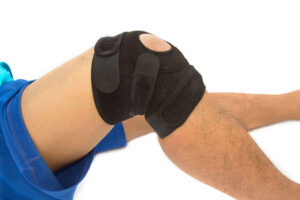One of the most common knee problems is a torn meniscus. Although this can be a painful, sidelining injury, many people put off a visit to the doctor. We’ll discuss what can happen when you ignore a torn meniscus.
The menisci are two pieces of tough, rubbery C-shaped cartilage that absorb shock in the knee joint. It’s an extremely useful little cushion—the knee is the largest joint in the body, taking on a weight-bearing load of more than one and half times your body weight with every step. It’s no wonder that an injury to the meniscus can be so painful and that leaving it untreated can sometimes lead to more knee problems.
 What happens if you leave a torn meniscus untreated?
What happens if you leave a torn meniscus untreated?
There are different types of menisci tears, and they can have different causes. Some injuries are a result of a sudden event, and some tears occur because of weakened or degenerative cartilage. A torn meniscus can happen during regular daily activities, but they commonly happen during sports, during motions that involve squatting or twisting, or as a result of direct impact.
Often, it’s possible to walk on a knee with a torn meniscus, leading many people to skip a doctor’s visit. However, within several days, the knee can get progressively worse, becoming stiff, swollen, and painful. Other signs of a meniscus tear include a feeling of your knee “locking”, giving out, or having limited range of motion.
Because the knee is a complex joint of many different parts, any untreated knee injury can lead to further problems. One of the reasons it’s important to consult a physician about a suspected meniscus tear is that it can often occur alongside an ACL (anterior cruciate ligament) tear—such as one professional soccer player and Chicago Center for Orthopedics (CCO) at Weiss patient experienced—or other knee injuries.
Conversely, a meniscus tear can occur after other knee problems. Check out this story about a collegiate athlete and Weiss CCO patient. His knee injuries led to a serious meniscus tear requiring a rare meniscal transplant performed by CCO physician, Dr. Preston Wolin, who is one of only a handful of surgeons performing this operation in the Chicago area.
Can a meniscus tear get worse?
If you don’t seek treatment for a meniscus tear, it’s possible for the injury to cause further knee problems down the line. Part of a torn meniscus can break off and become lodged in the knee joint itself, sometimes causing serious knee mobility issues and pain that require a more invasive surgery than an initial meniscus repair or treatment. An untreated torn meniscus can also lead to other long-term problems, including early development of osteoarthritis in the knee.
How long does it take for a torn meniscus to heal without surgery?
A meniscus tear is a very common injury, and not all meniscus tear treatments require surgery. However, there’s no way to have a proper diagnosis and treatment plan—even treatment that doesn’t involve surgery—without consulting with a physician experienced in knee problems. Meet the CCO doctors and check out our knee specialists to find a doctor that meets your needs.
Once a meniscus tear has been diagnosed, outpatient physical therapy is often a first line of approach. If your provider thinks you’re a good candidate for physical therapy, you’ll likely have therapy for about 4 to 6 weeks. For the best results from physical therapy, it’s important to be fully engaged, doing exercises at home as prescribed. It could be 8 weeks or more before you’re back to regular activities.
Some meniscal tears, however, won’t improve without surgery, so it’s important to consult with a specialist who can talk through your options.
 Will a knee brace help a torn meniscus?
Will a knee brace help a torn meniscus?
In addition to physical therapy, bracing is another conservative option sometimes tried after a meniscus tear. The goal of a knee brace is to protect it from further injury by providing stability and preventing you from overextending it beyond regular range of motion, and reducing the load on the meniscus. Through compression, a knee brace may even encourage circulation, which can aid in healing. Sometimes, your physician will recommend both physical therapy and a knee brace.
Conservative treatments may not be effective for some meniscus injuries and it can have a lot to do with what kind of tear it is and where it has occurred. If a tear occurs on the outside of the meniscus, it is more likely to be able to heal without surgery, because good blood flow to this part of the tissue can help the cartilage to repair itself. A tear on the inside of the meniscus, however, does not have this same blood flow to promote healing and may require surgery.
Talk to the Orthopedic Experts at Weiss
At the Chicago Center for Orthopedics at Weiss, we’ve gathered experts in knee conditions who can help diagnose and treat a torn meniscus. Although it’s a common injury, without proper treatment, it can lead to pain, decreased mobility, and even the need for more serious surgeries in the long-term.
To find an orthopedic knee specialist, request an appointment contact us today at 773-564-7770.

